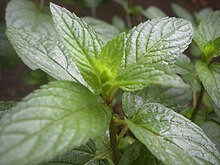
Back نعناع فلفلي Arabic نعناع فلفلى ARZ Mentha × piperita AST Бөтнөк үләне Bashkir Мята перцавая BE-X-OLD Menta pebrera Catalan Babuyna CEB Máta peprná Czech Krziżewé zelé CSB Mintys poeth Welsh
| Peppermint | |
|---|---|

| |
| Scientific classification | |
| Kingdom: | Plantae |
| Clade: | Tracheophytes |
| Clade: | Angiosperms |
| Clade: | Eudicots |
| Clade: | Asterids |
| Order: | Lamiales |
| Family: | Lamiaceae |
| Genus: | Mentha |
| Species: | M. × piperita
|
| Binomial name | |
| Mentha × piperita | |
| Synonyms | |
|
List
| |
Peppermint (Mentha × piperita) is a hybrid species of mint, a cross between watermint and spearmint.[1] Indigenous to Europe and the Middle East,[2] the plant is now widely spread and cultivated in many regions of the world.[3] It is occasionally found in the wild with its parent species.[3][4]
Although the genus Mentha comprises more than 25 species, the one in most common use is peppermint.[5] While Western peppermint is derived from Mentha × piperita, Chinese peppermint, or bohe, is derived from the fresh leaves of M. haplocalyx.[6][7][8] M. × piperita and M. haplocalyx are both recognized as plant sources of menthol and menthone, and are among the oldest herbs used for both culinary and medicinal products.[5][9]
- ^ Frampton, Alex (2011). The Complete Illustrated Book of Herbs. The Reader's Digest Association. OCLC 748502326. Archived on 6 April 2017.
- ^ "Peppermint". Botanical Online. Archived from the original on 19 March 2018. Retrieved 19 March 2018.
- ^ a b Euro+Med Plantbase Project: Mentha × piperitaArchived 9 March 2012 at the Wayback Machine
- ^ Flora of NW Europe: Mentha × piperita Archived 19 September 2009 at the Wayback Machine
- ^ a b Mimica-Dukic, N.; Bozin, B. (2008). "Mentha L. species (Lamiaceae) as promising sources of bioactive secondary metabolites". Current Pharmaceutical Design. 14 (29): 3141–50. doi:10.2174/138161208786404245. ISSN 1873-4286. PMID 19075696.
- ^ Dong, Wenjiang; Ni, Yongnian; Kokot, Serge (February 2015). "Differentiation of mint (Mentha haplocalyx Briq.) from different regions in China using gas and liquid chromatography". Journal of Separation Science. 38 (3): 402–9. doi:10.1002/jssc.201401130. ISSN 1615-9314. PMID 25431171.
- ^ "Mentha and Schizonepeta". ITM online. Archived from the original on 2018-12-26. Retrieved 2019-01-06.
- ^ Zhang, Feng; Lu, Yin; Qian, Wenhui; Pei, Zifan (2015), "Mentha haplocalyx Briq. 薄荷 (Bohe, Mint)", Dietary Chinese Herbs, Vienna: Springer, pp. 631–6, doi:10.1007/978-3-211-99448-1_72, ISBN 978-321199447-4
- ^ Bone, Kerry; Mills, Simon Y. (2013). Principles and practice of phytotherapy : modern herbal medicine (2nd ed.). Edinburgh: Churchill Livingstone. ISBN 978-0-44306992-5. OCLC 830314789.